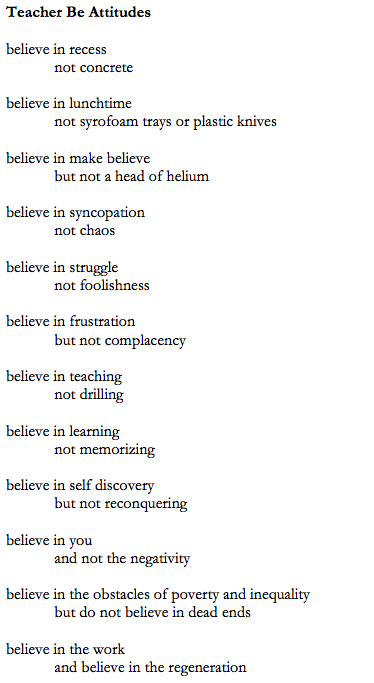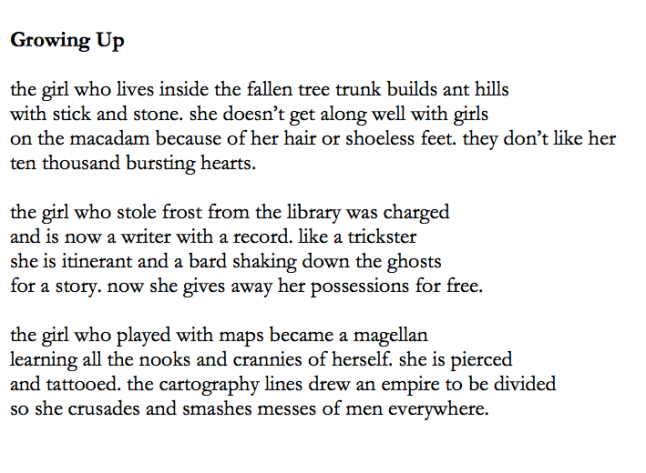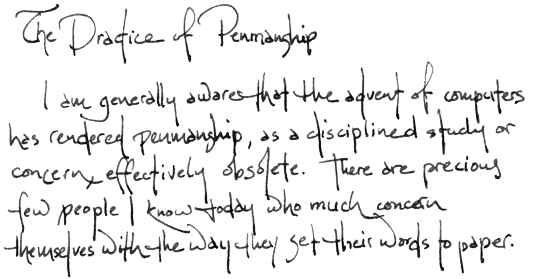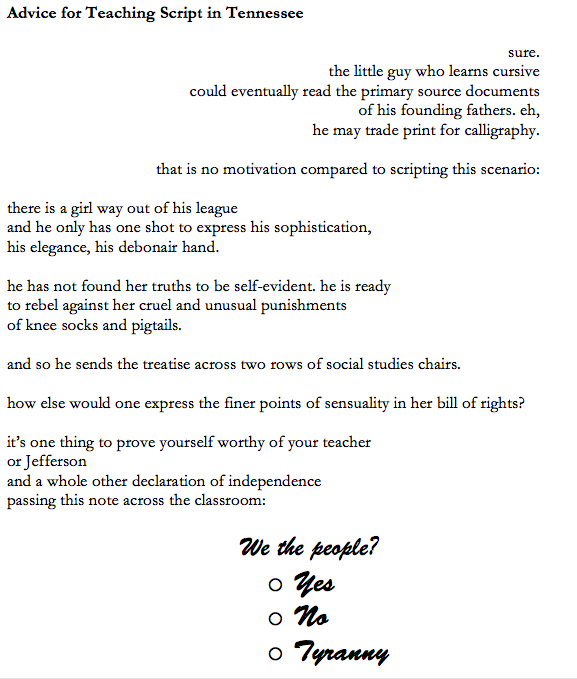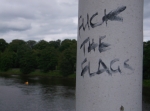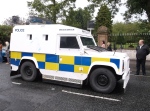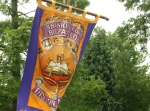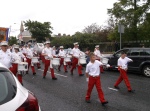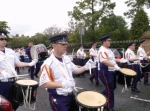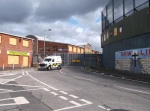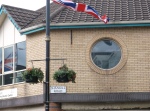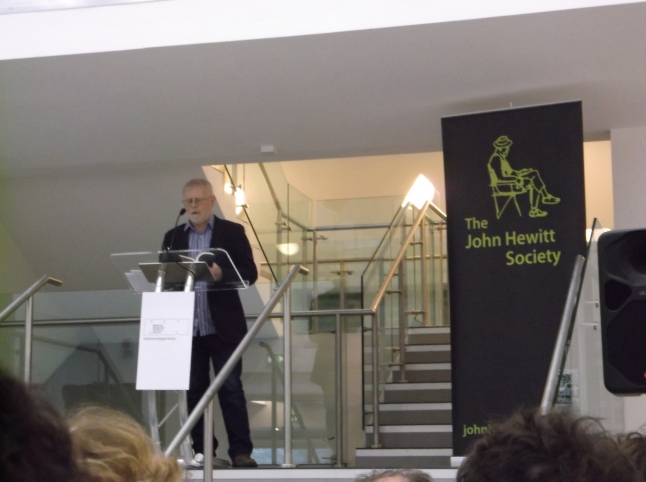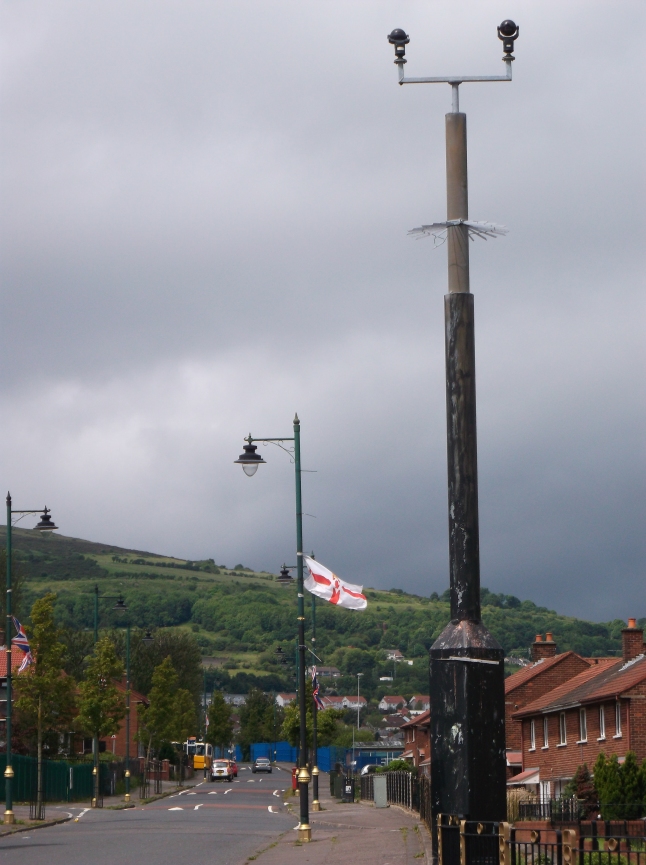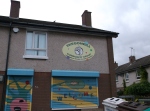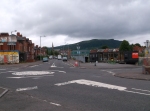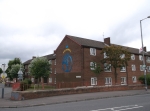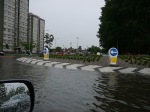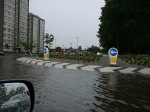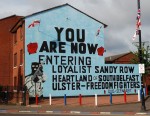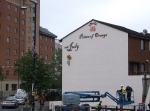Someday I will add some context to this poem, but for now, after a three day Expeditionary Learning Institute and 11 hours of travel from Indianapolis to Phoenix to ABQ to Taos, I think I will leave it here. Only two more poems to go!
Fund For Teachers
Careful Fellas
Handwriting: A Casualty of the Tests
To be fair, the art of penmanship (not penpersonship?) is dying because of the digital age. But with tighter national education standards, elementary teachers are finding less and less time to teach things like cursive. Tennessee State Representative Sheila Butt (she could never become a teacher with that name) is fighting to reestablish handwriting as a cornerstone of early education. One of her arguments is that students who do not know how to write script may not be able to read fundamental American texts in their original form. Not a bad idea. But that’s not going to help a lot boys learn how to write that way. Try this:
Is it a Parade, a March or a Riot-Inducing Intrusion?
Walked up the Shankill Road yesterday with economist Michael Leiden, Jr. (high school buddy visiting from London) I really wanted to see what happens in West Belfast when a parade, in this case a rather small one consisting of a dozen drum and flute bands, executes the itinerary and marches across the Peace Wall/Interfaces/Sectarian Divides. Really once we walked roughly a mile into the parade route, we decided to stop and catch up a bit. There was a police helicopter taking stock of the rainy afternoon from above. There was an amped up police presence on the street as well.
The summer season, either Marching Season or Riot Season depending on the source of information, is gearing up. The carnival atmosphere is not unique to yesterday. Public drinking. Street vendors. Children decked out in blue and red knick-knacks. As Neil Jarman explained to me Friday, there are about 2,800 marches across Northern Ireland in the summer time. The sky above the streets in any proper Protestant Unionist neighborhood across the six counties is crisscrossed with Union Jack bunting. This is true for the City of Derry’s Waterside neighborhood, the tiny town of Magherfelt and Belfast.
Stopping to get out of the rain with Leiden was a good thing in the sense that I am here to document the positive changes in the community, the bridge building. I don’t need to head home with sensational footage of angry Catholics and proud Protestants sowing the seeds of nightly skirmishes during each summer.
Most of these marches across the North are peaceful and not antagonistic. But in Belfast, with so many sutures still healing, I find it hard to imagine the need to march across the Peace Walls into Catholic neighborhoods. There are many arguments. Politically linked to the crown, all roads are the Queen’s Highways and they have every right to march where ever they want. To lose the marching tradition or concede the routes should be amended would be an admittance of defeat really, culturally and politically, in the eyes of Protestant neighborhoods. With the tenuous peace established in 98 and the call to be less sectarian, some Protestants believe their cultural identity is at stake.
This is the United Kingdom and these neighborhoods celebrate that fact in the face of, in spite of, or to communicate indifference towards the Irish nationalist agenda, a united Ireland across the island. Residents of the UK, as I have heard and can attest to with Mike accompanying me, are usually surprised at the use of flags and patriotism displayed. Residents of areas like Shankill are not Irish, and would like you to know that. And they’d like you to know where you and where they stand at all times.
Many Republicans I have talked to roll their eyes when I bring up these arguments I’ve heard. Fernando Murphey of the Interface Diaries and an Ardoyne resident says the bigger marches shut down neighborhoods for hours at a time. No way out, as he explained. He has participated in riotous protest of police collusion with the parade route coming through the neighborhood. There’s no way around it. And without the grating along these community borders, where would the young people have their craic, their fun/entertainment/action? I’ve heard on numerous occasions that Belfast is boring in these years since the Good Friday agreement, especially for youth. And if the daytime drinking on a Saturday was any indication of how both sides handle these summer celebrations, residents are well lubed for clashes by nighttime.
The parade is loud. The drums heralded the approach from blocks away. The drumming is intense. There is a sense of respect and quiet among the onlookers. There wasn’t waving or hysterics as they passed. People, if they weren’t already on the street, spilled out of the bars along the road to see the show. We saw the very end of the parade as it started on the Shankill, headed toward an Interface at the Peace Wall, and returned to the Shankill. Each drum group finished in a different area of the neighborhood. At a Church. At a hall. At a bar. Outside someone’s house.
Once again, shout out to Billy Moore, the Apprentice Boys’ General Secretary out of the City of Derry, as he goes out of his way throughout the year to communicate with Catholic Republican neighborhood associations to discuss routes, timing and necessity. He believes that is only fair.
There is a universal point to understand perhaps about marching and parades in general. The drums. Loud. I felt it carried an emotional weight to it. I think it would be intimidating if they were marching on my street and I was not celebrating. Simply due to the nature of what they are commemorating and the heartbeat of the music. And they knew I was not celebrating. And I knew they knew I knew. The wounds and scarring/healing process is fresh. But this could be said in the same light for people who don’t celebrate Gay Pride parades or marches for migrant rights or pro SB 1070 legislation in Arizona. I wonder if these aren’t the same type of celebration/commemoration-in-your-face-whether-you-like-it-or-not.
By the time it was all over, we were ready to head back to the city centre. The party was just starting. The sidewalks were standing room only outdoor watering holes. People were having great craic. I wanted to show him the big Peace Wall. We took our time checking it out. By the time we were done looking and wandering, the Interface where we entered the Shankill was closed. The two nearest exit points with the most direct route to downtown were sealed. It was 4:30 in the afternoon.
Beginning to See the Connections
I have finally been able to sit down with Mr. Jarman after emailing each other over the course of the last few months. He generously offered time and space for a meandering line of questioning. I really wanted to know more about issues with the youth, how communities deal with overlap at Interfaces and general political/economic trends in Northern Ireland. Neil was the man to see for sure.
Violence is trending down in Northern Ireland and Belfast specifically. This is due in a large part to the nature of violence itself. It is seen as more of a nuisance than it is a threat to community stability. Adults are not supporting the youth, or inflaming the excitable nature of young troublemakers into something that would catch on. The struggle remains though. The use of force has been legitimized by society over the course of the last generation or two. Think of it as riot as socializing. That’s why, I suppose, some people have told me that Belfast is boring now, and at least there was something to do during the Troubles.
Thankfully, cross community, and increasingly intra-community violence, is widely condemned and contained. Tomorrow I’ll be going to the Whiterock parade in the Shankill. There I’ll see how the Police Service of Northern Ireland (PSNI) has managed contentious events like marches. Reaction to community events such as these is proactive, not reactive, as Neil says. And the focus is on relationship building prior to the event, much like Billy Moore expressed in Derry.
I asked about youth counter culture. I am wondering if more and more communities are seeing young people avoid politics and religion altogether, thus avoiding sectarian associations and reminders. This question stems from my conversation with Chris Gaskins, the gentleman who helped me travel from Belfast to Derry. Neil used music as an example. Many young people are musicians in their traditional cultural way. But it is not an avenue to strike it rich or earn a record deal. Many Protestant youths are forming their own flute and drum bands and parading, while not necessarily affiliating with the Orange Halls or their parents and grandparents means of playing music. These bands are doing more touring than staying within their community. On the other hand, Irish traditional music is a session sport, and young musicians are finding this type of community to connect into. Once again the focus is not to make it rich.
These examples serve as a reminder of how young people are using the culture around them to create their own identity. And these examples of the music are unique to Northern Ireland.But I see connections with my students. It would be much like the youth from Taos forming drum groups on the Pueblo, or mariachi bands on their own. This happens regularly, of course with their own sense of flare and voice. Iwish I had more links for youth from the Pueblo and mariachi sounds. Lot of hip hop and drumming coming down the mountain.
Economically, Belfast is riding a wave of financial support from international sources to fund the peace process. This money is not going to last forever. Community posts like Sean Montgomery’s in Skegoneill are examples of this. Some people think the money trail will derail by the end of 2013, but no one really knows. Long term unemployment is high for the UK. But the City Centre is booming. Tourism is most definitely up. As my tour guide, Michael Rock, explained about the use of glass for store fronts. No one would have used glass during the Troubles. Bombs, right? Makes sense. The Riverfront district is no longer a smelly bog. The Cathedral Quarter is a shared space for commerce and foodies.
But Belfast is a ‘two-speed’ city. The service industry and related jobs are up and strong. The class divide is widening though. And the community residential divides are still alive and strong as evidenced by pictures from this week.
Politically speaking, with sweeping generalizations as Neil and I assured one another, I have noticed the Protestants feel a bit threatened by the peace process and fall out from 1998. In the sense that their political majority and hands on the steering wheel of the country are shaky. Catholics outnumber Protestants in the North, I think. But leading up to the Troubles Protestants held office and political power. That is changing very quickly.
Protestants, on a number of occasions with me, have expressed the concern that their culture is compromised. Neil thinks that is related to the call for communities to rein in the use of symbols and flags to combat paramilitary culture. Do you really need a masked gunman on a mural to celebrate your Protestant culture? Or is that a way to glorify violence and community terrorism? This seems like it would be akin to the Spanish community in Taos demanding their cultural images should be of the conquistadores, or the Anglos celebrating Kit Carson in public places.
Also the communities have been encouraged to gear their events, such as the bonfires, towards the family and not destructive, volatile, sectarian events. Address the use of alcohol at such events, as well. And as a shopkeeper told me in regards to the parade culture being under attack, Neil estimates of the 2,800 parades across the North, only about 100 are highly contested, meaning their route, timing, communication has to change. Once again, cheers to Billy Moore in Derry for addressing these issues through dialogue.
I am thankful for the time with Neil. He helped me form a picture of my own community as I think about the connections with Northern Ireland. But as he said, or something like it, if you try to understand Northern Ireland, you won’t understand Northern Ireland.
I wonder how our tiny town of 10,000 people reflects that sentiment. I wonder how yours copes. Is your community a collision of contradictions, divides and gulfs? Has your community used sport, or music, or public art to address shared identity? What are the next steps to grow together? This city is made of a fabric with deep neighborhood divides. I think everyone is just getting used to the peace, and quiet, and change. That’s more than enough, light years of progress, before they start looking at commonality. They may never.
Ah the Poets of Norn Iron
Finally I had the great honor to meet Colin Dardis at the John Hewitt Society’s reading last night. Hosted by the Ulster Museum, the reading commemorated the 25th anniversary of John Hewitt’s passing. He was a writer of Ulster planter’s stock. Lived rurally most his life, but also worked at the very museum hosting the event. I heard six poets read last night. A brief reading. Not to make my friends in New Mexico and Colorado jealous, but it rained so hard the welcoming speaker had to stop in the middle of his opening poem. That’s rain hitting the roof four stories up. Granted it’s modern architecture, so the hull of the building is open and vast. Nevertheless, it was nice to be sipping red wine and reveling in poetry with a new friend.
It was great to see Sinead Morrissey and Frank Ormsby read among others as I have prior knowledge of their work. Very cool.
Colin introduced me to his poetic mate Chris McLaughlin (from Strabane, but no relation to the Aidan McLaughlins), and we awayed into the rain to a local pub near Queen’s University waiting out the storm. We also enjoyed the first half of Spaiin and Portugal.
We talked about slam poetry and page poetry. They have a burgeoning performance group, Voce Versa, and I had just missed a performance two weeks ago. It was interesting to hear their views of the competition of poetry. The formula of writing for the performance. The scoring of words. Our experiences with the Spoken Work were not too far off. I tried to connect them with poets on the web who are not only bringing the heat to the performance but their work stands up on the page as well. Patricia Smith and Roger Bonair-Agard come to mind. Thanks, Verse-Converse!
As the night progress, Chris and I found ourselves out under the wet lamp light, munching sandwiches from the mini store because we had missed dinner speaking of football and poetics. I really wanted to know how poets interpret the Troubles into their work. I know so many poets in the Southwest recall the loss of their culture over the centuries and how it resurfaces in their family, identity and community. Chris essentially said that the Troubles in not in play as of yet. It would be too emotionally trite for poets to go there. Keep in mind we are talking about performance poetry here. An audience would cringe at any attempt to contextualize someone’s experience with hate and violence.
This was the first time I had heard that the Troubles did not touch everyone, whether by familial loss or community identity. I had always heard and assumed that the Troubles’ tentacles had reach around everyone’s leg and kept people wriggling to get away.
Chris did mention a poet, by the name of Colin Hassard. He has done a whopping piece called Norn Iron, or how the locals say Northern Ireland. He has some great lines. He doesn’t glorify, nor chastise. He captures the essence of what it means to be from here. It is well done. Hassard’s youth was “stopping football on the streets to let army cars pass.” This is what I was hoping to find from the poetry community. At least a conversation happening about how to communicate identity, sectarian or not.
Hear and see the poem here.
A few gems:
“where teenage dreams are easy to beat”
“Belfast built the Titanic and I have it on good authority Dublin built the iceberg”
“Norn Iron, you only have two seasons: winter and the rioting season” …I’ve been calling it marching season in past posts, sports fans.
“I refuse to wear a boller hat and I’m too pretty for a balaclava”
“my dream is to straighten out your Parliament, abolish your democracy and declare myself King”
“we should take more pictures, apartheid meat wagon is a beautiful image”
“if you believed in religion as much as you say you do, the churches would be overflowing and no one would have ever died”
“Norn Iron, youse are suckin diesel”
Check out Chris’ Soundcloud page and Colin’s work as well.
Erasing a Horrendous Scar
Fernando Murphey and Alan Waite have organized cross community effort to reconcile an area of North Belfast that has an infamous black eye. Many community organizations are using dialogue and circles to bring youth together from opposites sides of Belfast’s impressive divides. Murphey had had enough of trying to do this conventionally.
Much like Sean Montgomery in the Skegoneill, Fernando explained how these circles and dialogues take 4-8 weeks to get beyond the posturing and silence youth bring to the table. He wanted to innovate the process of bringing youth from each side. The Interface Diaries was born.
Fernando is from Ardoyne, a Catholic community of 7,000 people in North Belfast. Close by is the Shankill area. Wall are present. Some Interfaces are not. Notice the Eye in the Sky, as Fernando puts it, to recognize when you are crossing into another neighborhood.
This area is Interface is also notorious for a calamity of community overlap in 2001. After the Good Friday Agreement, communities boundaries, in some parts of Belfast, were redrawn and remade. Nowhere did this have such gross impacts. The Holy Cross Girls School, a Catholic primary school, is now located about 300 yards from where the above picture was taken. Before the communities recognized the right and necessity of busing the girls these few football fields, the young girls were exposed to a gauntlet of hate and violence from the local Protestant Unionist residents. Balloons of urine were thrown at the girls. A bomb exploded on the third day and killed a police dog. The following video shows the ugliness and reality of communities growing up together in times of peace. If not for the 9/11 Attack in New York, people have speculated this dispute would have been global news.
http://www.youtube.com/watch?v=K6vNyCQHxr8
But now the Interface Diaries is using the format of video diaries to connect youth in each community. Instead of wasting precious time, Fernando and Alan decided to record young boys asking questions of boys the same age across the divide. The recipients would record their answers and send the video back to the other side. By the end of four weeks, when youth workers would just be scratching the surface of progress, the young people on both sides were chomping at the bit to meet the people they saw on the television screens. They wanted to be friends. The questions were hardest hitting at the beginning of the process. Culture, politics, history, stereotypes. These questions turned into questions about relationships, music sports.
This process was first used with young men, but the second installment of the Interface Diaries deals with young women. A couple of the girls were involved in the Holy Cross dispute eleven years ago. After building the bridges between the communities, Fernando and Alan bring the group together with a traveling experience. This year the girls visited Manchester and met members from that city’s minority community.
The Interface Diaries is a unique and compelling project model for Belfast. The project is not at a loss for potential grant money. I will be in touch with Fernando and Alan to see if we can get them or students to visit Taos. We can build bridges together.
Skegoneill-Glandore
In the Skegoneill, the casual city wanderer (of which there are very few in this city, perhaps for fear of mistumbling somewhere improper) could not distinguish the fact this tiny roundabout is home to an Interface community. Not all Interfaces, where two communities come together, are separated by walls looming above, between, around. This community in North Belfast is home to Protestant Unionists east of the roundabout on Skegoneill, and Catholic Republicans west on Glandore.
The community center in this area is unique and encouraging. A brief documentary, Life as an Interface, explains how people from both sides of the Interface have needed to cross the invisible border between the communities. These people have had to come to grips and find solutions for what it means to share common ground. Sean Montgomery was hired a few years ago to be a community organizer. Through the International Fund for Ireland, the community center mustered the funds to hire full time community workers to help their neighborhood. It seems like more areas in Belfast operate on a hair trigger. In West Belfast this very week, violent flare ups have been associated with Interfaces and sectarian youth due to the Queen’s visit. This area is no different.
Going back as recently as 2006-7, there was a community call in the Skegoneill to cut down the constant conflict at the Interface. One community member opened a shop at the roundabout to reclaim the defunct open lot between the two communities. Both sides of the street utilize the shop and buy their free range eggs from the owner’s hens wandering around the Interface. A beautiful suture to reconnect the area.
Sean was entering the predominantly Protestant area as a Republican. People knew this. On his first day tensions were high. But he has an uncanny ability to speak the truth clearly. A man of his word, Sean has been able to take the emotional levels of conflict down a level. But he quickly found the pulse of the conflict and found the tensions in this area to be stemming from a familial conflict over the past few years. Once he knew and the community understood the conflict wasn’t political tensions dialed back.
One initiative Sean led was to take back the bonfire area next to the store on the roundabout. During marching season, enormous bonfires are assembled and lit in vacant lots across Unionist areas. But for the time of the year when no bonfires are lit, this lot was full of broken glass, broken bricks and trash. Sean pushed the community to help clean it and turn it into a space where small music festivals could be held. Success!
They developed a charter for the Skegoneill with a mission statement to facilitate programs in the neighborhoods, but “not to dilute someone’s culture.” There are shared parades for Christmas and Halloween. There has been a push from Sean to make sure there are no overt uses of sectarian or political symbolism for either side in Skegoneill-Glandore. Though last week he was away from the neighborhood and an older lady from the Unionist side hired young boys to put Union Jacks and bunting up around the neighborhood. Goes without saying, she’s not a big Sean fan.
Sean has incorporated a Let Youth Lead program to empower youth in the area addressing non-judgmental approaches to drugs and violence to change anti-social behavior. I love how drug use and violence is termed anti-social. It seems drug abuse and violent behavior are two ways the youth demonstrate their handle on our societies, both here and in Taos. Also, from youth feedback, Sean sees that the best age to work with youth is the 13-14 year olds. The older teenagers are telling Sean these ages are simply looking up to people and aping what they see. If change is to come, it would start with addressing this age group. I can attest. Sometimes our social justice curriculum falls flat with the high school crowd, as it is social suicide to be intelligent.
Sean is a certified youth worker, so most of the Skegoneill’s programs focus on the youth, as stated. He is now helping the North Belfast Youth Practitioners Forum to solidify youth work in across the north of the city. Progress is being made in this tiny area of North Belfast.
The Apocalypse
Kidding, but…here’s what happens when a former IRA man shakes hands with the Queen!
A city in flux, rolling with the punches. A couple posts for you tomorrow.
Belfast, Sort of Gray
Greetings from Belfast. Of course arrival was Sunday night. One night of wandering. Two days of purposeful searching. The city is bustling. Much like the City of Derry, locals have capitalized on the peace from the Good Friday Agreement and tourism is booming. The Crown Bar is a must see for the nightly reveler with its stained glass windows and 19th Century accoutrements. This lies across the street from the Europa Hotel, allegedly the most bombed hotel on the planet. No personal pictures as I just haven’t snapped them yet. Tons of seagulls live in this port city. They congregate after lunch above the buildings and talk about leftovers. Their calls were never so ominous at the beaches along the East Coast. But the brick and mortar monoliths capture their calls and throw them down the streets against the other buildings. One bird’s call can be heard for blocks. Oh yes, I was a Seagull in a former life…
Yesterday I found my way, finally, after much cross Atlantic communication, with the generous people at the Institute for Conflict Research. John Bell sat me down and we discussed the various community organizations that would be of service to my study. He also shared with me his perspectives on the clashes, crises and rebuilding efforts around Belfast society. More to come from his contacts as I have set up meetings for tomorrow and into next week with community organizers and Belfast youth.
Katy Radford, whom I had been in close contact with via email, welcomed me warmly and offered more help. Most interesting is what’s happening next Monday. Along with monumental stepping stones toward reconciliation like the Queen meeting with Martin McGuinness, an ex-IRA man now the First Deputy Minister of Northern Ireland, communities are reshaping their identity. Murals, as Ms. Radford put it, are what Belfast does. One of the most infamous Unionist murals is in Sandy Row, just a few blocks from my hotel. Sadly I did not go see it Sunday night because it is being removed and repainted with a less intimidating image, but still one with pride in their Protestant roots. A portrait of William III, famous from this blog in such topics as the Battle of the Boyne, the Orangemen and the Seige of Derry, will grace this wall. Whereas I wasn’t able to capture the old gunman ominously welcoming you to Sandy Row, I will be able to document the passage of this week with footage from the mural making process. Next Monday I will attend the unveiling ceremony and a brief reception where I will be able to rub elbows with cucumber sandwich wielding muralists and community members. Enjoy the contrast.
This is a small example of communities redefining their identity through murals and public art. This tradition in Northern Ireland goes back to the early 1900s when Loyalist communities shared their imagery on the walls of their areas. William, the Prince of Orange, was their muse. Artists, often from a single family, would retouch the murals each marching season. This outward demonstration of identity was civic duty, recognized and legitimized by the state and the governing party. Republicans had less freedom to fly flags, paint murals or march. Thanks to Bill Rolston’s books on Irish murals for this info. More to come on local murals.
